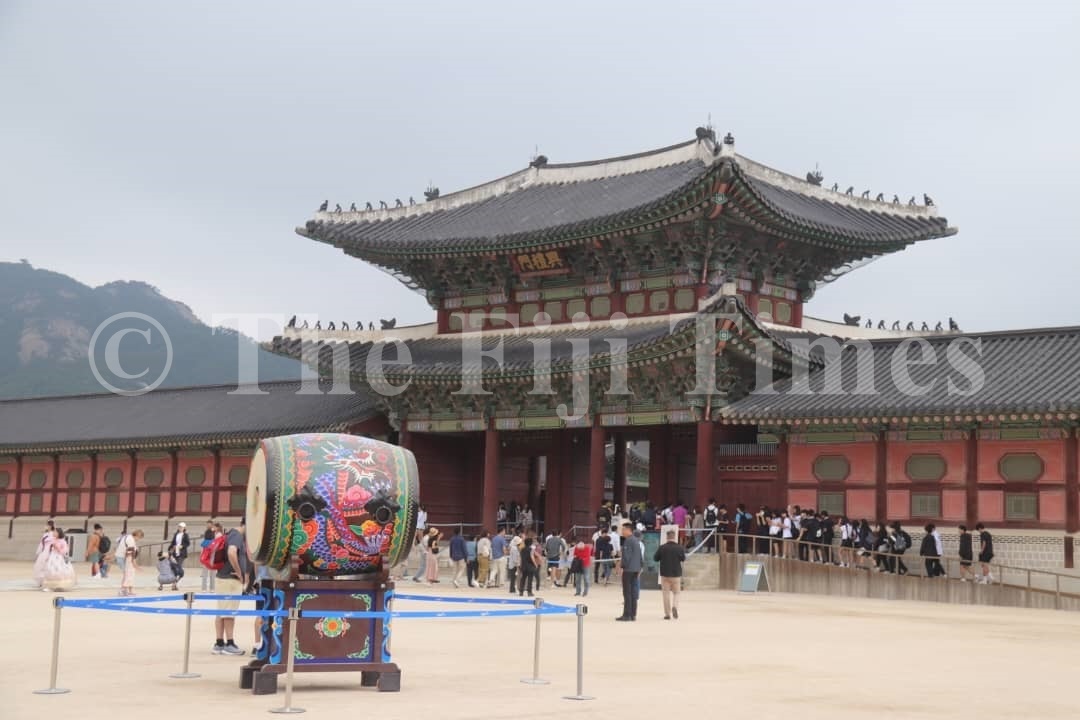History has always been a subject I’ve been passionate about since my childhood days. And I guess you could say this was because of my dear mother, Olive Kotoisuva.
That Papua New Guinean woman would talk for hours about the history of our descendants, all the while jumping from one story to another.
So, imagine the excitement I had when I learnt that one of the places, we were visiting in South Korea was Gyeongbokgung Palace.
I first learnt of the palace during the opening night of the Korea Tourism Photo Exhibition held at Damodar City Cinema cine lounge in November last year. I fell in love with the place and told myself I would visit the place one day.
During our bus tour around Seoul on my very first day in South Korea, I caught a glimpse of palace. I did a silent prayer hoping we’d visit during the one week and my dreams came true.
Established in 1395 as the main palace, Gyeongbokgung is located in northern Seoul and is the largest of the five grand palaces built by the Joseon Dynasty, which was founded by Yi Seong-gye in July 1392 and replaced by the Korean Empire in October 1897.
The kingdom was founded following the aftermath of the overthrow of Goryeo in what is today the city of Kaesong. Early on, Korea was retitled and the capital was relocated to modern-day Seoul.
It was during the 500- year reign of the dynasty that Confucian ideals and doctrines were entrenched in Korean society.
The palace served as the home of kings of the Joseon dynasty, the kings’ households, as well as the government of Joseon. Gyeong-bok means brilliance and fortune – given by a renowned Neo-Confucian scholar statesman, Jeong Dojeon.
He played a key role in establishing the Joseon Dynasty, the name reflects its founders wishes for the dynasty to thrive and prosper.
The palace was destroyed by a fire in 1592 when a huge Japanese army under the command of Toyotomi Hideyoshi invaded Korea.
The palace stayed in ruins for about 270 years until 1867 when a restoration project was launched by Heungseon Daewongun, the then head of government during 1820 to 1898. About 500 buildings were restored or newly built because of this project.
This included the inner and outer palace offices in which the king and his government officials performed their duties, the residences and other related buildings used by the king, queen, court ladies and the royal gardens.
The restored palace suffered significant damages at the hands of the Japanese colonial authorities during the Japanese authorities during the Japanese occupation from 1910 to 1945.
In 1915, for instance over 90 per cent of the palace buildings were demolished under the pretext that the Korean Product Promotion Fair would be held in the grounds of the palace.
A full-fledged project to restore the palace was launched in 1990, including the demolition of the Japanese Government general building which had stood in the palace grounds for about 70 years. Gyeongbokgung Palace is a top tourist attraction site in Seoul.
We were fortunate to have timed the changing of the palace guard ceremony.
The ceremony reenacts the custom of the royal court during the Joseon Dynasty when guards used to ensure the safety and security of the king and his court.
At Gwanghwamun Gate, tthe main entrance to the palace, visitors can see the event twice a day at 10am and 2pm.
For all the BTS lovers, the Gyeonghoeru Pavilion (located inside the palace premises) was where the group performed their song Mikrokosmos on The Tonight Show starring Jimmy Fallon in 2020.
The name Gyeonghoeru is a reference to the king and how he had succeeded to be a great leader when he was surrounded by the right people.
A two-story pavilion was built in 1412 during the reign of King Taejong. About 60 years later, during the reign of King Seongjong (1469-1494), the pavilion began to tilt.
It was decided that the pavilion would have to be rebuilt. Gyeonghoeru Pavilion burned down by the Japanese in 1592 during the Imjin War.
The current structure dates to 1867. The current pavilion as seen today was built in 1867 during the reign of King Gojong.
The pavilion is one of the only structures at the palace that survived the Japanese occupation of Korea from 1910 to the end of World War in 1945.
A stone wall once surrounded the pond but was removed during the occupation. Part of this wall was restored between 2004 and 2005.
The cool part about visiting the palace is that visitors can hire a hanbok (traditional Korean clothing) just outside the palace and wear it during the duration of the tour. Here you’re able to get a feel of what it was once like some years centuries ago.
You can also take amasing pictures. We didn’t get a chance to wear that at the palace, but I was happy I got to try it on another occasion, during our visit to Cheong Wa Dae a.k.a Blue House (formerly the presidential office and residence.) A big thank you to our tour guide who broke everything in detail about the palace.
Because we were pressed for time, we didn’t get to tour the whole palace grounds. But we were grateful we got to experience it, which was more than enough. Gyeongbokgung Palace I will see you in a few years and this time I hope to tour the entire grounds wearing a hanbok (traditional Korean dress).
Join me next week as I tell you about the Cheong Wa Dae tour in Part Five.



